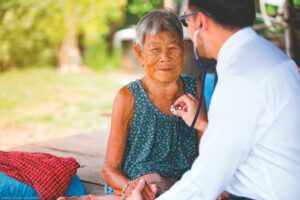 A common case scenario in our practice in North Dakota is a woman with rheumatoid arthritis on methotrexate monotherapy. She is a member of the Sisseton Wahpeton Oyate people and lives 90 miles from our rheumatology clinic. She currently has moderate disease activity, indicating the need for additional treatment. She does not have her own vehicle, but a family member has generally been able to drive her to appointments at six-month intervals. Increasing the frequency of appointments is likely to be challenging. She does have a cellular telephone, but does not have access to fixed broadband service in her home.
A common case scenario in our practice in North Dakota is a woman with rheumatoid arthritis on methotrexate monotherapy. She is a member of the Sisseton Wahpeton Oyate people and lives 90 miles from our rheumatology clinic. She currently has moderate disease activity, indicating the need for additional treatment. She does not have her own vehicle, but a family member has generally been able to drive her to appointments at six-month intervals. Increasing the frequency of appointments is likely to be challenging. She does have a cellular telephone, but does not have access to fixed broadband service in her home.
This scenario illustrates several challenges in the provision of effective and equitable rheumatologic care for our patients, including the rural location, transportation limitations and healthcare inequity.
As rheumatologists, we have an ethical obligation to address the barriers that exist to equitable care for our patients. In the next few paragraphs, we outline current challenges to care for rural and Indigenous peoples and discuss strategies to address these barriers.
Rural Health Challenges
Access to healthcare in rural areas is progressively contracting. As of early 2023, 124 rural hospitals had closed their doors over the past 17 years and an additional 425 rural hospitals are financially vulnerable, based on a 2020 report by the Chartis Group.1
In rheumatology, projections estimate a shortage of 4,100 rheumatologists, with demand exceeding supply by 102% in 2030, and disproportionate effects expected in rural areas.2
Patients in rural areas face the challenges of increased travel time and associated costs, including time away from work to attend appointments. Additionally, rural patients are more likely to be managed by a non-rheumatologist, with associated diagnosis delays and higher use of corticosteroids.3
Although efforts are ongoing to improve access to technology, such as broadband internet, the digital divide remains a significant barrier for telemedicine services in rural areas.4 Rural populations tend to be older, and the lower technological literacy associated with that population can further exacerbate this digital divide.
Indigenous Patients
The Centers for Disease Control and Prevention (CDC) defines health disparities as “preventable differences in the burden of disease, injury, violence, or opportunities to achieve optimal health that are experienced by socially disadvantaged populations.”5
For American Indian and Alaska Native (AI/AN) patients, not only are there issues with transportation and broadband access, but also systemic disparities in diagnosis and manifestations of rheumatoid arthritis. Many AI/AN patients, such as the Cree/Ojibwe, Pima and Chippewa people, have a prevalence of rheumatoid arthritis at around 2–3%, near the highest prevalence worldwide, and linked to the prevalence of HLA-DRB1*1402.6 Other tribes have increased prevalence of HLA-B27 and associated spondyloarthropathies.7 Studies have shown that AI/AN patients not only present with severe RA, but also carry multiple poor outcome risk factors.6
Disproportionate burdens in delivering care for RA exist in AI/AN and rural populations. The Navajo Nation—the largest American Indian reservation, spanning 27,000 square miles across three states and home to 250,000 tribal members—faces a severe shortage of local rheumatology providers.8 Similarly, healthcare disparities are observed in systemic lupus erythematosus (SLE), particularly in its prevalence, disease activity, damage accrual, severity of disease manifestations (lupus nephritis) and disease outcomes (end-stage renal disease). These observed differences have led to the recognition that being a member of a minoritized or marginalized community may be an independent predictor of disease outcome in SLE.9
Telemedicine to Close Gaps
Although continued barriers exist to equitable care in rural areas and, in particular, for our American Indian/Alaska Native patients, the adoption of telemedicine has provided an opportunity to reach geographically distant populations. Concerns about the digital divide, as well as the inability to perform a complete physical examination, are ongoing barriers to the use of telemedicine in rheumatologic care.
A recent systematic review of the use of telemedicine in rheumatology demonstrates neutral effects of telemedicine on patient satisfaction, disease activity and quality of life, and a positive effect on medical costs.10 Clearly telerheumatology is, and will continue to be, an integral component of future care models; however, several practical and ethical considerations are necessary to maximize patient outcomes utilizing telemedicine.11,12 These include ensuring adequate establishment of the physician-patient relationship, maintaining respect for patient privacy, receiving adequate telemedicine training and understanding telemedicine legislation.10
Rural residents have been shown to access their providers through the internet less frequently than their urban counterparts.13 The Extension for Community Healthcare Outcomes (ECHO) program, an educational forum for in situ primary care providers, has proven valuable in expanding access to rheumatology care.14
Additional Interventions
Although telemedicine shows great promise for addressing care gaps in rural areas, it cannot stand alone, primarily due to issues of technology access. Additional approaches are needed to ensure adequate rheumatologic care.
1. Educate non-rheumatology clinicians.
Primary care physicians and advanced practice providers are generally at the forefront of care in rural areas. Programs to educate clinicians on rheumatologic care have been developed and will continue to be necessary to improve the early recognition and treatment of different rheumatic diseases. The Rheumatology Access Expansion (RAE) initiative has indicated that providing high-quality rheumatology training and mentoring to frontline primary care providers in vulnerable communities can have a positive impact on many patients suffering from rheumatic disease.8
2. Integrate social work & nurse care managers into rheumatology practice.
Transportation issues, insurance barriers and complex social situations require a team approach and cannot be addressed by the rheumatologist in isolation. If integrated social work or care management is not possible in the rheumatology clinic, then engaging the patient’s primary care provider or social work team can provide needed support to address barriers.
3. Create outreach rheumatology clinics.
Although barriers to providing care in outreach clinics exist in terms of rheumatologist time and travel costs, these clinics can be an additional tool to provide in-person visits for patients with significant travel burden. Rheumatologists must be compensated adequately for their time and travel costs.
4. Work closely with local clinics to coordinate care.
This approach can be particularly helpful for a patient with internet access barriers. If a patient has transportation to a local clinic, nursing staff can frequently oversee a telemedicine visit and assist with obtaining relevant clinical information. Community health workers, who have been integrated into care for AI/AN communities since the 1960s, can serve as an additional resource for reaching patients.15 Care coordination also includes aggressively managing environmental factors and comorbidities, including tobacco use and obesity, which are associated with an increased incidence of rheumatic conditions, such as RA.16
5. Advocate for reductions in drug pricing.
Drugs used to treat rheumatic conditions, particularly biologics, have significant costs, which has the potential to exacerbate disparity in management and outcomes in rheumatologic disease. Rheumatologists should advocate with legislators, industry and payers to reduce the inequities that arise from the high cost of drugs.
In Sum
Although we have many tools to address healthcare disparities, ongoing research is needed to address additional barriers and gaps in rheumatologic care.
For our patient, we may need to work with social workers to ensure transportation to at least annual or twice yearly visits and augment that with telemedicine visits every three months utilizing her cell phone and electronic medical record (EMR) integrated videoconferencing. We may additionally coordinate with her local providers and provide them with education on disease flares, as well as drug adverse effect(s) and administration considerations. Her treatment will be optimized by initiating combination disease-modifying anti-rheumatic drugs, as well as providing adequate ancillary care and education.
With this type of customized, team-based approach, we hope to better serve our rural and minority patients with effective and ethical care.
 Laura Nichols, MD, practices internal medicine at Sanford Health, Fargo, N.D.
Laura Nichols, MD, practices internal medicine at Sanford Health, Fargo, N.D.
 Lee Graham, MD, is a rheumatology specialist, retired from his practice in Westmont, Ill.
Lee Graham, MD, is a rheumatology specialist, retired from his practice in Westmont, Ill.
 Erdal Diri, MD, is a clinical associate professor of medicine at the University of North Dakota, Fargo.
Erdal Diri, MD, is a clinical associate professor of medicine at the University of North Dakota, Fargo.
Acknowledgments
The authors thank Anne Bass, MD, for her invaluable support as the chair of the ACR Committee on Ethics and in her shepherding role for this article. Special thanks are also due to the dedicated members of the Ethics Committee for their insightful feedback during the drafting process.
References
- How to improve health care in rural areas [blog]. Tulane University. 2023 Jan 17.
- Battafarano DF, Ditmyer M, Bolster MB, et al. 2015 American College of Rheumatology workforce study: Supply and demand projections of adult rheumatology workforce, 2015-2030. Arthritis Care Res. 2018;70(4):617–626.
- Lennep DS, Crout T, Majithia V. Rural health issues in rheumatology: A review. Curr Opin Rheumatol. 2020 Mar;32(2):119–125.
- Fourteenth Broadband Deployment Report. Federal Communications Commission. 2021 Jan 19. https://docs.fcc.gov/public/attachments/FCC-21-18A1.pdf.
- Health disparities. Centers for Disease Prevention and Control. 2023 May 26. https://www.cdc.gov/healthyyouth/disparities/index.htm.
- Hitchon CA, ONeil L, Peschken CA, et al. Disparities in rheumatoid arthritis outcomes for North American Indigenous populations. Int J Circumpolar Health. 2023 Dec;82(1):2166447.
- Peschken CA, Esdaile JM. Rheumatic diseases in North America’s Indigenous peoples. Semin Arthritis Rheum. 1999 Jun;28(6):368–391.
- Mandal J, Carroway T, Izadi Z, et al. The rheumatology access expansion (RAE) initiative: Improving rheumatoid arthritis care on Navajo nation through primary care provider education (poster 0005). Arthritis Rheumatol. 2022;74(suppl 9).
- Hasan B, Fike A, Hasni S. Health disparities in systemic lupus erythematosus-a narrative review. Clin Rheumatol. 2022 Nov;41(11):3299–3311.
- Jackson LE, Edgil TA, Hill B, et al. Telemedicine in rheumatology care: A systematic review. Semin Arthritis Rheum. 2022 Oct;56:152045.
- American College of Rheumatology Position Statement on Telemedicine. American College of Rheumatology. 2020 Jun 29. https://assets.contentstack.io/v3/assets/bltee37abb6b278ab2c/blt0c00d75c71e0ae20/acr-position-statement-telemedicine.pdf.
- Qaseem A, MacLean CH, Tierney S, et al. Performance measures for physicians providing clinical care using telemedicine: A position paper from the American College of Physicians. Ann Intern Med. 2023;176(5):694–698.
- Jackson LE, Danila MI. Healthcare disparities in telemedicine for rheumatology care. Curr Opin Rheumatol. 2022 May 1;34(3):171–178.
- Fillon M. Patients help themselves: Program evolves from community based participatory research. The Rheumatologist. 2020 Feb;14(2):38.
- Community health workers in tribal communities. Rural Health Information Hub. 2011 Sep 1. Updated 2020 Sep 8. https://www.ruralhealthinfo.org/toolkits/community-health-workers/4/adapting-programs/tribal-communities.
- Finckh A, Gilbert B, Hodkinson B, et al. Global epidemiology of rheumatoid arthritis. Nat Rev Rheumatol. 2022 Oct;18(10):591–602.


